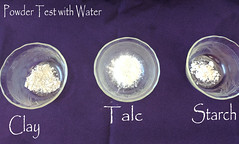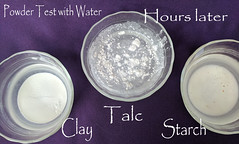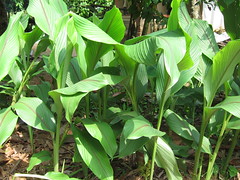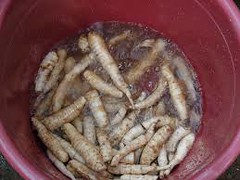
The Three Powder Experiment, Why Do It?
It’s not unusual for me to run tests and experiments. I do it all the time when developing new products or new blends. I just don’t always let people in behind the scenes. But when it came time to experiment with how I wanted to design the Très Spa body powders, it seemed like a fun project to share with everyone.
There are three types of powders used in making any body powder; Talc, Clay, or plant based starches. But which one is the best one to use? I decided to do a little three powder experiment to see what happens to each of the main ingredient types used in manufacturing powder under water and oil conditions. Here is what I found
Designing The Conditions
I wanted to see what happens with powders applied to the skin. Considering many people use powder on their pits and private parts, and those glands secrete both water and oil I decided to use those catalysts as my test condition. My goal was to demonstrate and observe the behaviors of each of the three main powder ingredient classes (talc, clay, plant starch).
Now before you call me out on design of experiments and scientific research, I know what you are going to say. This is not a scientific journal and this is not a peer reviewed article. This is “kitchen counter” observation designed for fun and to make us think. Pretty easy to do and very easy for anyone to do at home.Believe me I had to harness my engineering training in order to not get complicated.
Set Up The Three Types
I divided my experiment into three types of powders that are used by most manufacturers of body powder. 1) Clay. A blend of micro fine minerals. I used Kaolin which is the most popular in cosmetics. 2) Talc. A mineral mined from the earth. I had some old talc powder in the back of my bathroom cupboard that must have been over 20 years old by now. You know the one, the big name brand that they encourage you to use even for a baby, that one. 3) Plant Starch. Leafy green plants grown every year. For this one I used a pure botanical blend that had no clay or talc, the Très Spa Organic Silky Skin Dusting Powder served for this category.
My experiment was a very simple design since there really is no need to get too fancy here! I observed and photographed each step. I confess that I was not too surprised by the results but I thought the visuals would help demonstrate each one. Turns out, it also makes a great narrative for you to understand how I make the millions of decisions that go into each one of the Très Spa products.
First up, The Water test
Step 1) Measure a quarter of a teaspoon of each and placed it in a clear glass dish.
Observation; Texture, when dry: Each one felt silky to the touch but the talcum felt like it had more “slip” to it. It also seemed to send puffy clouds of dust at the slightest of movements. Clay and plant starches felt about the same, soft with glide.
Step 2) Add warm tap water. Not too hot, just warm to the touch.
Observation; Just add water? Out of the gate, it was clearly obvious why Talcum was such a hit with powder manufacturers. It is very hydrophobic. When I poured the water in, it went around the talc but not through it. When I poured the water into the Clay and the Starch dish, they seemed to dance with the water as if they would dissolve and blend. Since the clay is hydrous, it’s easy to see why it would play along for the most part. After all, water played a huge role in the mineral being formed in the first place!
Step 3) Stir each one with a spoon.
Observation: No matter what I did to it, that talc was having nothing to do with the water. It just laid on the surface and when I tried to stir it up, it clung to the spoon and clumped together but would not have anything to do at all with the water. The clay and the starch seemed to partner with the water as long as I stirred. Once I stopped stirring you could see it begin to separate.
Step 4) Let rest a couple of hours 
Observation: The talc did nothing. Nothing at all. After a couple of hours you could see the separation was more significant in the clay than in the plant starch. The plant starch water seemed to be a bit more cloudy. This could be due to a small fraction of the material being water soluble. It could also be that the clay molecules were heavier so settled faster. You would have to test that variable.
Step 4b) Let rest over night 
Observation: Again the talc did nothing. At the side view you could tell the water was a bit clearer with the clay than the starch. Now I am no scientist but I believe starch is a polysaccharide made of gloucose monomers with two types of molecules amylose and amylopectin. The structure is a hollow helix which makes it excellent for storage and for energy but it’s going to take more than water to break it down. Amylose, unlike amylopectin, is not cold water soluble.
Step 5) Apply heat 
Observation; Nothing noteworthy here. In fact they all seemed to remain the same, just a little hotter. I had gotten used to the talc not budging and I figured the clay wouldn’t care about the heat, but I thought the starch might do something. But alas, I was wrong. Plain tap water wasn’t going to do a thing. Nothing.
Time for Phase 2 testing, The Oil Test
This was an interesting test for me and I’m not sure why I got the results I did get, but I found it very interesting. If you want to try this at home, I used Organic Jojoba oil since it matches the skins natural sebum. In case you were wondering what sebum is, it’s that waxy oily substance we mammals secrete to lubricate and waterproof our skin. Sebaceous glands piggy back with hair follicles.
Step 1) Measure out about a 1/4 of a teaspoon of each into a glass dish. 
Observation: I have no colored dishes at all so I had to use these leaves my Grandmother painted over 50 years ago. I think she would be thrilled to be a part of one of my experiments. Someday I’ll have to tell you about the time she let me experiment with hors d’oeuvre for a tea party she was having. I think I was 8 at the time.
Step 2) Add a splash of oil. 
Observation: Do my eyes deceive me or does it seem the oil and starch are already getting familiar?
Step 3) Stir

Observation: The starch seemed to melt in with the oil like long lost halves of a whole. The talc astounded me with similar action. But when it came to the clay, that was another story. I stirred and stirred and stirred and it did not want to blend. I think you can still see bits of clumps.
Step 4) Let it rest 
Observation: They all appeared the same after blending, well at least close enough. Nothing of interest for me there but, given a little time, the strangest thing started happening. The starch dish had a clearly powdery deposit around the edge. When I touched it, it was soft and silky and felt dry to the touch. As time went on, so did the talc. The clay was sticky and goopy. I confess that I kept returning to the dishes and playing with the powder.
Step 5) Overnight 
Observation: Eventually the entire dish for the talc and for the plant starch turned to look like a powder again. The viscous character of the oil was gone as if it had never existed. They had been transformed into powder cakes you could brush on and the texture was soft and silky. The clay was still sticky and goopy to touch. Not at all pleasant.
Perhaps you can tell me why this transformation happened?
As far as a conclusion, I’ll let you make your own. I made my choice a long time ago for Très Spa, Plant Based all the way! The only way to keep it pure, sustainable, and organic.

 What it takes to make a purely natural powder
What it takes to make a purely natural powder







 Yes! Of course Très Spa is cruelty free skincare. I would think our logo and our tag line would be a ‘give-away’ but we know it is important to make the statement clear and loud. So there is no doubt about it, we only use plant based ingredients. There is no need to test our products on anyone or anything to know its potential side effects. Our ingredients have been used for centuries so the record is very long! In some cases hundreds of years long.
Yes! Of course Très Spa is cruelty free skincare. I would think our logo and our tag line would be a ‘give-away’ but we know it is important to make the statement clear and loud. So there is no doubt about it, we only use plant based ingredients. There is no need to test our products on anyone or anything to know its potential side effects. Our ingredients have been used for centuries so the record is very long! In some cases hundreds of years long. So what does it mean when a company says their products are cruelty free? It means that no animal was tested using the product. It is not a controlled claim in that there is no governing body but it is generally accepted and a common practice. However, the cruelty free standard only goes so far. It does not expand beyond the manufacturer of the finished goods. Historically it did not reach into the entire supply chain for each and every one of the ingredients that goes into that end product. So the claim falls a bit short of the mark in our opinion (but we do have some pretty high standards).
So what does it mean when a company says their products are cruelty free? It means that no animal was tested using the product. It is not a controlled claim in that there is no governing body but it is generally accepted and a common practice. However, the cruelty free standard only goes so far. It does not expand beyond the manufacturer of the finished goods. Historically it did not reach into the entire supply chain for each and every one of the ingredients that goes into that end product. So the claim falls a bit short of the mark in our opinion (but we do have some pretty high standards). New compounds designed in a lab don’t have the same advantage as natural ingredients do, century’s worth of human “hands on experience”. Nature, in its unaltered state or un-isolated, the totality is well known and records have been well established. Now, there are some that would argue that testing has been done in the past and they may be correct. But that testing would have been decades ago.
New compounds designed in a lab don’t have the same advantage as natural ingredients do, century’s worth of human “hands on experience”. Nature, in its unaltered state or un-isolated, the totality is well known and records have been well established. Now, there are some that would argue that testing has been done in the past and they may be correct. But that testing would have been decades ago. We have all seen the labels and the marketing material stating that a product is hypoallergenic. What makes it so, what does that mean, and why say it? It’s a marvelous word signifying the product is less apt to cause an allergic reaction. It sounds so clinical, official and sterile. Like nothing bad could happen to you if you used this product. The word hypoallergenic makes you think that this is skincare you can trust.
We have all seen the labels and the marketing material stating that a product is hypoallergenic. What makes it so, what does that mean, and why say it? It’s a marvelous word signifying the product is less apt to cause an allergic reaction. It sounds so clinical, official and sterile. Like nothing bad could happen to you if you used this product. The word hypoallergenic makes you think that this is skincare you can trust. cosmetics. You make a line of foundation make up. You have a long list of ingredient compounds that go into this foundation product. Say you start getting feedback that there is a part of the population that is having an allergic reaction (usually slight redness, heat, or itchiness). You want happy customers! So you go back to your lab and you isolate the compound that may be the perpetrator and you either change your formula a bit and re release as “Re Formulated” or you run a new line with a new set of compounds and call it “Hypoallergenic”.
cosmetics. You make a line of foundation make up. You have a long list of ingredient compounds that go into this foundation product. Say you start getting feedback that there is a part of the population that is having an allergic reaction (usually slight redness, heat, or itchiness). You want happy customers! So you go back to your lab and you isolate the compound that may be the perpetrator and you either change your formula a bit and re release as “Re Formulated” or you run a new line with a new set of compounds and call it “Hypoallergenic”. With Très Spa, we feel natural plant based is the best for you and for the planet. So we create products in Harmony with Nature and we disclose all of the ingredients on our website as well as our labels. Très Spa products serve a broad spectrum of customers and some that suffer from allergies to various ingredients as well as those with particularly challenging skin conditions like psoriasis and eczema. So even though Très Spa products could be considered hypoallergenic, we choose not to actively market that. We feel it is far better to use natural and botanical ingredients in our formulations and disclose what each ingredient is then let you, the consumer, choose what works best for you. After all, you know what you are allergic to.
With Très Spa, we feel natural plant based is the best for you and for the planet. So we create products in Harmony with Nature and we disclose all of the ingredients on our website as well as our labels. Très Spa products serve a broad spectrum of customers and some that suffer from allergies to various ingredients as well as those with particularly challenging skin conditions like psoriasis and eczema. So even though Très Spa products could be considered hypoallergenic, we choose not to actively market that. We feel it is far better to use natural and botanical ingredients in our formulations and disclose what each ingredient is then let you, the consumer, choose what works best for you. After all, you know what you are allergic to.